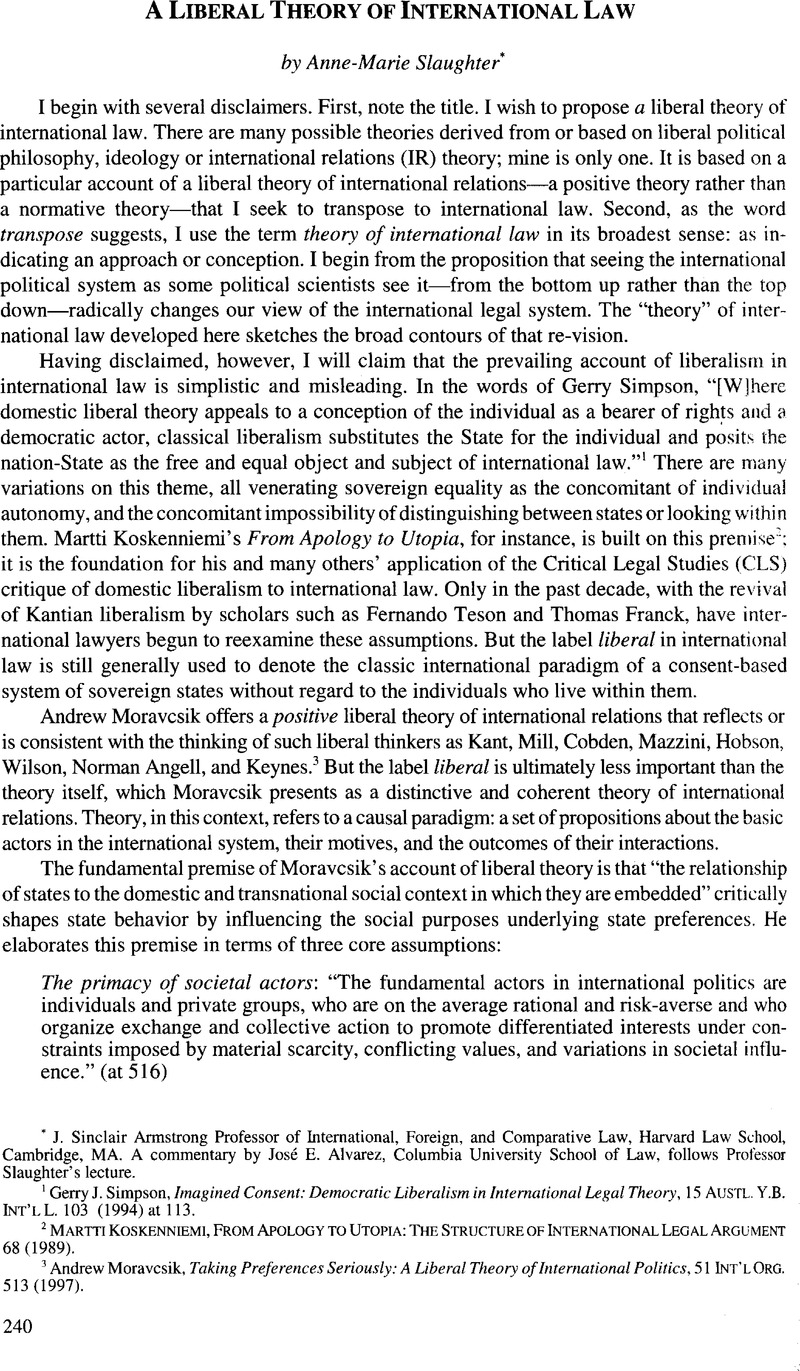Article contents
A Liberal Theory of International Law
Published online by Cambridge University Press: 28 February 2017
Abstract

- Type
- Meeting Report
- Information
- Copyright
- Copyright © American Society of International Law 2000
References
1 Simpson, Gerry J., Imagined Consent: Democratic Liberalism in International Legal Theory, 15 Austl. Y. B. Int’l L. 103 (1994)Google Scholar at 113.
2 Mariti Koskenniemi, From Apology to Utopia: The Structure of International Legal Argument 68 (1989).
3 Moravcsik, Andrew, Taking Preferences Seriously: A Liberal Theory of International Politics, 51 Int’l Org. 513 (1997)CrossRefGoogle Scholar.
4 Hedley Bull, The Anarchical Society: A Study of Order in World Politics 127-61 (1977). I also use international order interchangeably with world order and global order, although I recognize the many ways in which these conceptions can differ.
5 Kenneth Neal Waltz, Man, The State, And War: A Theoretical Analysis (1959).
6 Cooter, Robert, Structural Adjudication and the New Law Merchant: A Model of Decentralized Law, Int’l Rev. L. Econ. 143, 144 (1994)Google Scholar.
7 Virginia Haufler, Internation Al Business Self-Regulation: The Intersection of Private and Public Interests (2000).
8 Simmons, P.J., Learning to Live with NGOs, 1998 Foreign Pol’y 88 Google Scholar.
9 See Yves Dezalay & Bryant G. Garth, Grand Old Men vs. Multinationals: The Routinization of Charismatic Arbitration into Off-Shore Litigation, sees. IV, VI (American Bar Foundation Working Paper No. 9317) (] 994).
10 Haufler, supra note 7.
11 Zaring, David T., International Law by Other Means: The Twilight Existence of International Financial Regulatory Organizations, 33 Tex. Int’l L. J. 281 (1998)Google Scholar.
12 Alvarez, José E., Crimes of State/Crimes of Hate: Lessons from Rwanda 24 Yale J. Int’l L. 365 (1999)Google Scholar.
13 Carter, Ashton et al., Catastrophic Terrorism: Tackling the New Danger, 11 Foreign Aff. 80, 86 (1998)CrossRefGoogle Scholar.
14 Charlesworth, Hilary, Feminist Methods in International Law, 93 AJIL 379, 391 (1999)CrossRefGoogle Scholar.
15 I am indebted to Hilary Charlesworth for prompting my thinking on this question.
16 Abram Chayes & Antonia Handler Chayes, The New Sovereignty (1995).
17 For a complete database on old and new international tribunals, see the Project on International Courts and Tribunals, obtainable from <http://www.pict-pcti.org>.
18 Secretary-General Proposes Global Compact on Human Rights, Labour, Environment, in Address to World Economic Forum in Davos, UN Press Release SG/SM/6881 (Jan. 31, 1999), obtainable from <http://www.un.org/Depts/dhl/resguide/press/htm>.
19 However, work like Thomas Franck’ s effort to establish an individual-level “right to democratic governance” is important and equally applicable to all citizens of all states. See Franck, Thomas M., The Emerging Right to Democratic Governance, 86 AJIL 46 (1992)CrossRefGoogle Scholar.
20 Mansfield, Edward D. & Snyder, Jack, Democratization and the Danger of War, 20 Int’l Security 5 (1995)CrossRefGoogle Scholar.
- 19
- Cited by




